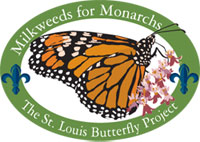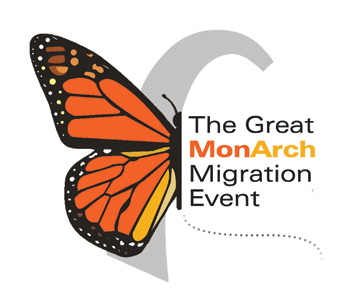Milkweeds for Monarchs
Milkweeds For Monarchs: The St. Louis Butterfly Project is an effort to create pollinator habitat in ways that foster the connection between people and nature
About the Initiative
 On Earth Day 2014, former Mayor Francis Slay launched Milkweeds for Monarchs: The St. Louis Butterfly Project to foster the connection between people and nature where they live, work, learn and play.
On Earth Day 2014, former Mayor Francis Slay launched Milkweeds for Monarchs: The St. Louis Butterfly Project to foster the connection between people and nature where they live, work, learn and play.
Milkweeds for Monarchs (overview document here) aligns with the City of St. Louis Urban Vitality & Ecology and Biophilic Cities efforts, and advances objectives in the City of St. Louis Sustainability Plan. The City led the effort in 2014 by establishing 50 monarch gardens; most of these gardens are located at fire houses and City parks. The community was challenged to plant an additional 200 monarch gardens to celebrate the City's 250th birthday. Gardens that were then registered appear on the Milkweeds for Monarchs Map. The urban program was expanded in 2015-16 to create 50 school monarch gardens, and then to create a St. Louis Riverfront Butterfly Byway - a collection of sites totaling a 30-acre pollinator pathway along the Mississippi Riverfront. The Butterfly Byway was completed in the Spring of 2018, and includes interpretive panels at prominent locations.
How to Create a Monarch Garden
- DESIGN: Review the STL Monarch Mix list of recommended plants.
- FIND: Check the Finding Plants Guide if you need assistance locating STL Monarch Mix plants.
- CREATE: The back side of the Milkweeds for Monarchs Overview Brochure has instructions for how to create a monarch garden.
- REGISTER: Register your new monarch garden online for it to appear as a butterfly icon on the community map (see below).
- CARE: Follow the Plant Care Tips when caring for your monarch garden.
- SHARE: Enjoy your garden and the butterflies that visit! Share photos via wernerc@stlouis-mo.gov or Tweet them to @STLSustainable.
- Use the iNaturalist or Journey North app to report your monarch sightings.
Milkweeds for Monarchs Garden Criteria
- Garden must be located in the City of St. Louis.
- Garden should be newly planted or expanded (this may include adding STL Monarch Mix plants to a pre-existing garden).
- Garden should contain 4 milkweed plants representing at least 2 different milkweed species (example: 2 Butterfly Weed plants and 2 Swamp Milkweed plants).
- Garden should contain 5 nectar plants representing at least 3 different species (example: 2 Purple Coneflower plants, 2 Goldenrod plants, and 1 Black-Eyed Susan plant).
- In total, garden should contain a minimum of 9 plants, covering at least one square meter (approximately 9 square feet). Using the STL Monarch Mix is strongly recommended.
Register Your Monarch Garden (City only)
Register your Garden to have it appear on the citywide map, and to help us count the number of monarch gardens created in the City of St. Louis.
View Map and Description of Monarch Gardens registered in the City of St. Louis to check on the citywide impact for creating monarch habitat!
Milkweeds for Monarchs In The News
-
The Great MonArch Migration Event has been held for the past 5 years on National Public Lands Day in partnership with the National Park Service at Gateway Arch National Park. [The September 2017 and 2018 MonArch Migration events have photo galleries from previous years).
-
Milkweeds for Monarchs: The St. Louis Butterfly Project was featured in a New York Times Magazine piece on How to Attract Butterflies (June 2019).
- For help in creating the Monarch Butterfly Origami, check out this short (4 minute) origami video tutorial created by Landscape Architecture students at Iowa State University (September 2018).
- 2017 St. Louis Monarch Photo Contest winners (August 2018)
- St. Louis Riverfront Butterfly Byway Map (July 2018)
- St. Louis Riverfront Butterfly Byway Interpretive Panel (May 2018)
- American Planning Association magazine article about Milkweeds for Monarchs: The St. Louis Butterfly Project efforts (November 2017)
- Catherine Werner's presentation on the City's urban monarch conservation efforts at the Smithsonian Institution Wild Cities: The Buzz About Urban Pollinators (June 2017)
- The City submitted its final report to the USFWS on urban monarch conservation education, outreach & research programs (Feb 2017)
- In partnership with the Missouri Botanical Garden, Saint Louis Zoo, and U.S. Fish & Wildlife Service, the City created Monarch Gardens for Schools: A Resource Guide for PreK-12 Urban School Communities (Feb 2017)
- Map highlighting the City's monarch conservation efforts 2015-2016 (Feb 2017)
- The City received the US Conference of Mayors GRO1000 Gardens & Greenspaces national award to create monarch habitat areas along the St. Louis Riverfront Butterfly Byway (Jan 2016)
- Milkweeds for Monarchs was featured in the December American Planning Association's Urban Design & Preservation publication, titled "St. Louis is Aflutter for Monarchs" (Dec 2015)
- Mayor Slay's leadership in urban monarch conservation efforts are featured throughout the National Wildlife Federation's guide to monarch conservation in cities (Dec 2015)
- The City received a $155,000 Monarch Conservation grant from NFWF for a new St. Louis Riverfront Butterfly Byway (Sept 2015). The Butterfly Byway will have been established in early 2018, and include interpretive panels at several locations.
- Mayor Slay launched the NWF's Mayors' Monarch Pledge with National Wildlife Federation president, Collin O'Mara (Sept 2015)
- Planting a Future for Monarchs - USFWS article featuring Milkweeds for Monarchs: The St. Louis Butterfly Project (August 2015)
- Catherine Werner's webinar presentation on urban monarch conservation, featuring Milkweeds for Monarchs (July 2015)
- City of St. Louis received an $80,000 grant from USFWS to advance urban monarch conservation through research and outreach (June 2015).
- STL Monarch Origami (April 2015)
- U.S. Conference of Mayors Newsletter (May 2014)
- Community Builders Network Article: Building Community - One Butterfly at a Time (July 2014)
- Biophilic Cities Interview of Mayor Slay and Catherine Werner (August 2014)
- Milkweeds for Monarchs Initiative update (Summer 2014)
- STL TV's City Corner: Milkweeds for Monarchs interview with Catherine Werner (August 2014)
St. Louis Monarch Tools & Resources
The Great MonArch Migration Event
The City and National Park Service have annually partnered to hold The Great MonArch Migration Event in September of 2017-2021 at the Gateway Arch National Park in conjunction with National Public Lands Day. Due to Covid-19 safety consideration, the 2020 and 2021 events were modified for health safety, and limited to offering a Monarch Garden In A Box native plant sale of 9 native plants from the STL Monarch Mix collection. The boxes were available for $30 apiece and were fulfilled by partner nurseries. The first 50 people who collected their pre-ordered Monarch Garden In A Box received a free Monarch Butterfly bag.
Partner Monarch Butterfly Information
Check out the following resources to learn more about monarchs and monarch habitat:
- Tips on how to successfully grow milkweed (from Monarch Watch)
- Backyard Habitat Requirements for Monarch Butterflies
- Monarch Joint Venture Research Reviews 2019-20 and 2020-21 summarize numerous mponarch butterfly research projects.
- Bee-Toxic Pesticides Found in “Bee-Friendly” Plants Sold at Garden Centers Gardeners Beware 2014 Report
- Guide to Native Milkweeds-Pollinator Plants of the Central United States
- Plant Ecology, Seed Production Methods, and Habitat Restoration Opportunities: Milkweeds-A Conservation Practitioner's Guide
- List of midwestern Best Nectar Plants for Monarchs
- Conservation Status and Ecology of the Monarch Butterfly in the United States
- Evaluation of Butterfly Gardens for Restoring Habitat for the Monarch Butterfly
- Selected Readings and Resources, such as monarch-related curriculum materials, citizen science and field guides
- Monarch Butterfly Conservation Webinar Series presented by the Monarch Joint Venture and the United States Fish & Wildlife Service
- Various monarch materials - The Monarch Joint Venture
Monarch Garden Location Open Data
Milkweed for Monarchs garden data is available for download in the open data portal.
Help Us Improve This Page
Did you notice an error? Is there information that you expected to find on this page, but didn't? Let us know below, and we'll work on it.
Feedback is anonymous.
